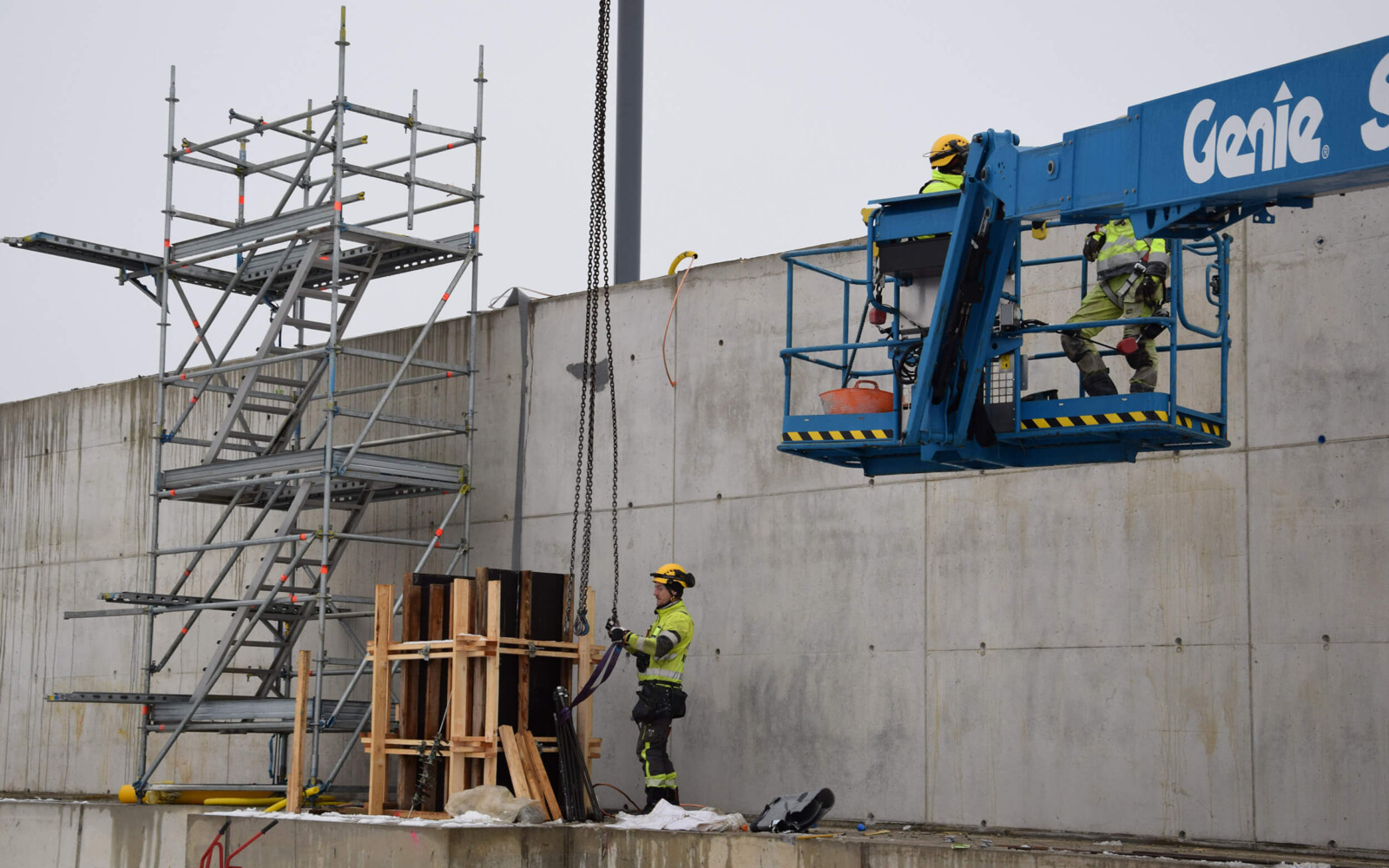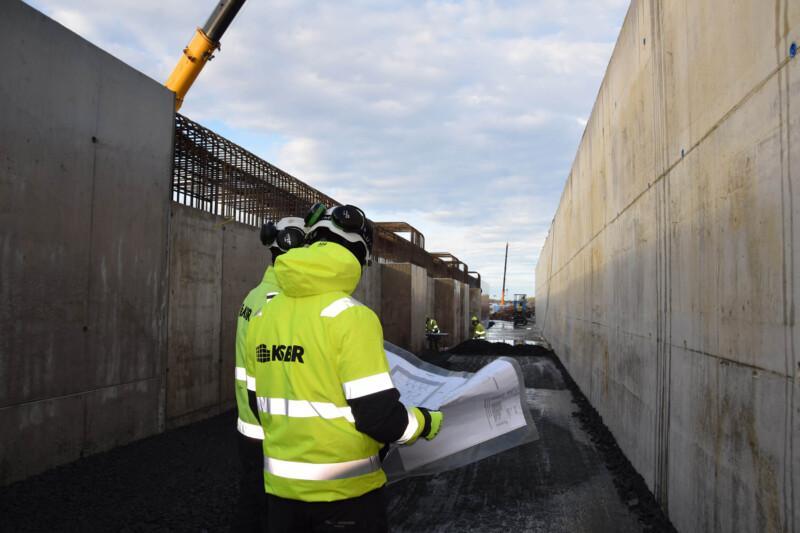
Winter construction calls for a cool head – and warm concrete
Finland’s distinct seasonal variation has an impact on every aspect of construction, particularly when working with heat-retaining concrete. Luckily, KSBR’s professionals are used to solving problems in difficult conditions and on tight timelines.
As a full-service construction provider, KSBR offers a wide range of services for the industry. The company’s roots, however, are in concrete – and they’re a unique specialist in cast-in-place concrete. A strong understanding of the properties of concrete contributes to both the efficiency of the company’s construction and the quality of the end result. One key principle is connected to the timing and conditions of concrete construction.
“Concrete construction is best done in summer conditions. It’s not a dealbreaker, but in practice it’s generally advisable and more cost-effective,” says KSBR Site Manager Matti Laaksonen.
Temperature drops to zero and below create challenges for concrete setting and its strength curve. There are ways to avoid these issues, but they require extra work and resources in both heating and protection. This can, in turn, affect the project schedule and increase cost pressure.
“Project schedules are often such that the work has to be finished regardless of the season,” says Harri Kytökangas, Project Manager for industrial construction.
“In the Nordics, contractors generally understand the challenges of winter, which of course affect all construction. But many may still not know in detail, for example, how much energy is required just to heat the aggregate at the production end. Solving these issues is what we do.”
Freezing temperatures increase heating needs and strain equipment
The effects of cold on concrete are most evident in thin structures. These issues can’t be solved with the properties of the concrete itself – protection and heat are needed to achieve the appropriate temperature. Concrete pumps are also put through their paces when temperatures drop to around -15 degrees Celsius, i.e., the typical minimum operating temperature for pump equipment, and below.
“It’s occasionally been necessary to pour in temperatures as low as -20 degrees Celsius, for example, because of delays in concrete delivery – but then there’s a high risk of equipment breakage,” says Laaksonen.
Similarly, the concrete station starts to perform poorly at around -20 degrees Celsius, as heating at those temperatures requires a huge amount of energy.
“When we’re planning on-site concreting, we ask the mass supplier for a thermal simulation of the behaviour of the concrete mass under predicted winter conditions, if necessary. This shows what the concrete has to be like when pumping starts. Its temperature is then monitored and, if necessary, we ask a concrete mason to increase power to the boiler. But even then, the power limit can sometimes already be reached at
-15 degrees.”

Creative problem solving and construction in the heart of winter
KSBR’s advantages include the strong experience and problem-solving skills of its professionals, who have developed creative solutions for even the most demanding weather conditions.
“For example, in one wastewater treatment plant project, we built the heat exchange system ourselves. Circuits from the heat exchanger were inserted into the ductile iron pipes to heat the walls of the wastewater treatment plant basin. Developing these tried-and-true techniques has been something of a pioneering effort in our product development,” says Laaksonen.
Winter conditions should also be taken into account in the planning and sequencing of construction. For example, by scheduling major foundation work in spring and frame installation in the autumn, the frame can be properly closed and sealed for the winter. This will provide protection from the weather and heat the building for floor construction.
That was the case for the Sibanye-Stillwater lithium project in Kaustinen, which kicked off in spring 2024 and has included the construction of the Keliber concentrator and water works, as well as foundation work for the crushers. Construction reached its peak between November to mid-January and mid-February. This went well for a number of reasons, according to Laaksonen.
“The winter was rather mild, which made it easier to work and reduced heating costs. We had our own steam equipment conveniently available, and a good steam subcontractor too. That allowed us to prepare for winter’s challenges without too much effort. Also, all the structures in Kaustinen were primarily solid structures, whose inherent heat-absorbing capacity reduces the need for large shelters.”
Concrete requires – and generates – heat as it strengthens
Let’s get back to the specific properties of concrete, which include its ability to generate heat. When the structure receives sufficient heat, even in winter concreting, the concrete itself begins to form as it hardens.
Under normal conditions, concrete starts to set around four hours after it’s prepared. The lower the temperature of the concrete mass, the longer this process takes. That’s why the goal is to achieve an initial temperature that doesn’t drop significantly below 20 degrees in those first few hours. After successful setting, strength begins to develop – and the temperatures start to rise.
“When the retaining walls were poured in Kaustinen, the initial temperature of the concrete mass was about 22-25 degrees Celsius. At no point did it drop below 18 degrees before the mass started to develop strength and produce heat. The temperatures then rose to the desired 58 degrees, even though it was -15 degrees outside at the time,” recalls Laaksonen.
“Once the concrete reaches a compressive strength of 5 MPa, the structure can withstand freezing. Once frozen, it doesn’t develop strength, but its heat buildup will start again once it defrosts. In practice, a strength of 5 MPa is not yet enough to ensure that a defrosted structure will still hold together after freezing. But if the structure reaches, for instance, 60% of its design strength before freezing, its internal temperature can hit zero and continue to strengthen again when temperatures rise in the spring.”
The post-construction phase in their projects includes structural sheltering, or curing, which in winter concrete construction usually lasts slightly longer than in summer conditions.
“Concrete standards have specific curing times for certain load classes as to how long the structure has to be kept covered. The curing period should be long enough for the concrete to reach 60-80% of the design strength, but no less than one week. If you pour a 30-centimetre slab foundation in freezing temperatures, you have to shelter it for even a few weeks, maybe until the snow melts in spring,” says Laaksonen.
Contingencies for the contingencies
With careful planning, preparation and preparedness, KSBR has always been able to complete winter concrete projects with flying colours.
“We haven’t had any major problems with planned casting and schedules. Of course, you always have to be more prepared than usual for winter conditions. You need to have contingencies for the contingencies,” says Kytökangas.
“Planning is even more important in winter. You really need to be prepared for every possible and imaginable problem. At KSBR, our individual concreting planning is already highly refined, so it’s just part of the routine,” Laaksonen continues.
But can this concrete professional come up with anything good about winter?
“Of course, crisp winter weather or nice spring days can lift your spirits, but I can’t think of much else,” says Laaksonen.
Kytökangas cuts in: “In the winter you can get even better concrete service than usual, since you might be the only customer.”
